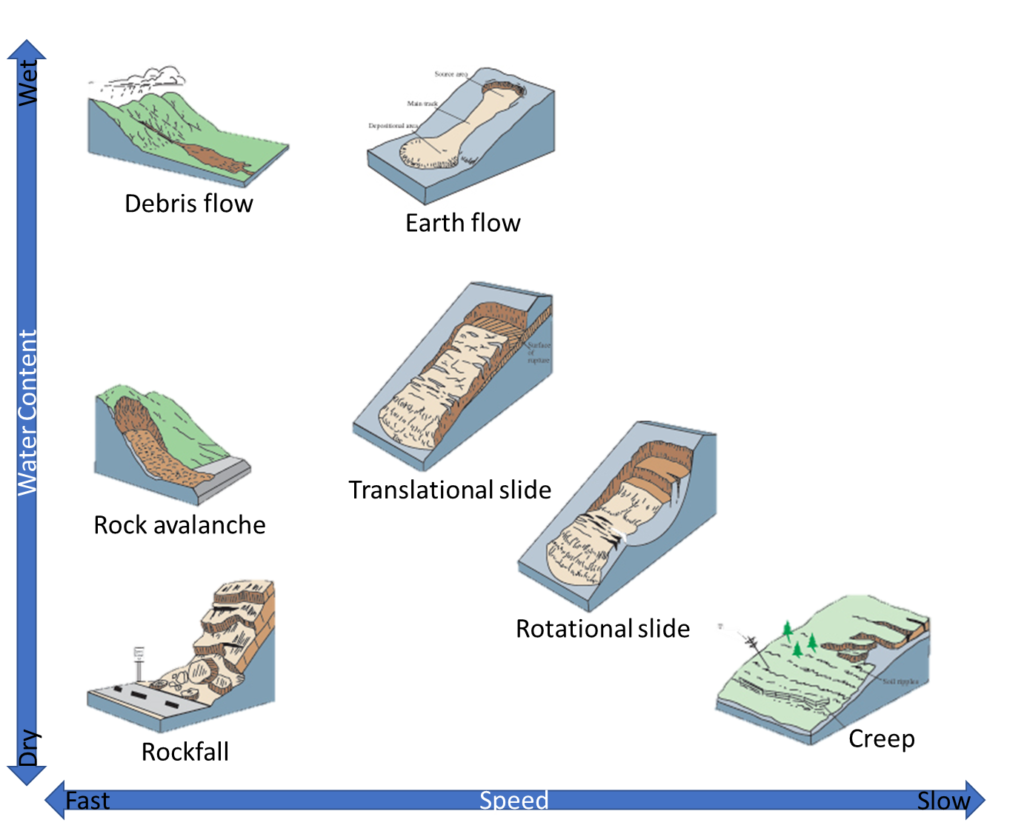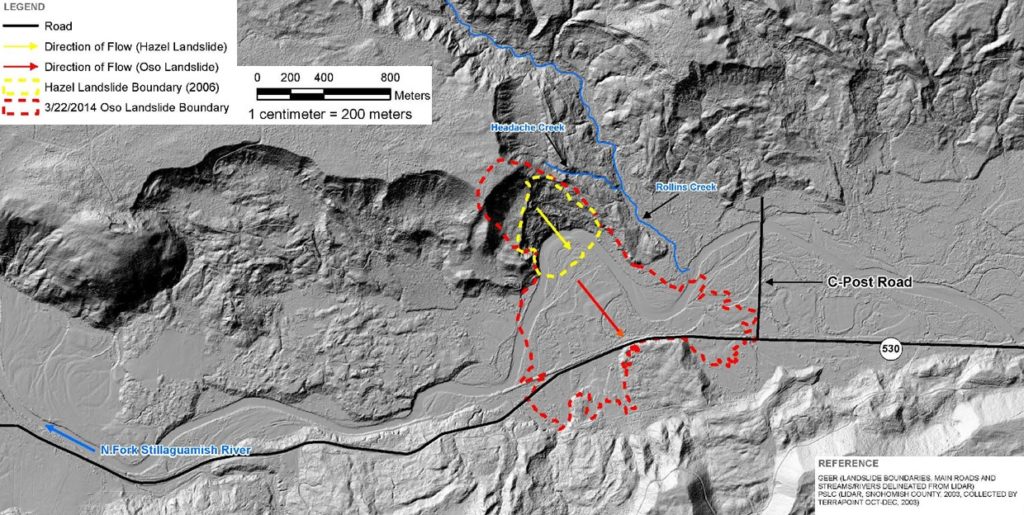Main Body
Chapter 16
Topic 16 – Gravity Never Sleeps – Mass Wasting
On March 22, 2014 at 10:37 am a hillside just outside of Oso, Washington collapsed, sending a wall of mud and debris across the Stillaguamish River towards a small settlement of people and Washington State highway 2. The material buried the community in about 7.6 million cubic metres of debris, claiming the lives of 43 people and injuring 10 others, and causing over $50 million in damages. It is the deadliest recorded landslide in US history. After the event, there was significant discussion about whether the event could have been predicted or avoided, and the various roles that natural causes and human influence increased the impact of the disaster.
When Earth materials like rock or sediment exist on a sloped surface, gravity continuously pulls downward on those materials. When the force of gravity overcomes the resisting forces, holding the material against the slope, it moves downslope. Sometimes this movement occurs rapidly, over a number of seconds. Sometimes it occurs over the course of years or decades, at a rate imperceptible to the human eye. Collectively, all processes that involve the downslope movement of Earth materials are referred to as ‘mass wasting’.
As a process, mass wasting is part of a larger geomorphic cycle called ‘dynamic landscape equilibrium’. The landscape equilibrium concept suggests that endogenous and exogenous forces interact to create a balance across the Earth’s surface. For example, tectonic forces are acting to uplift the Himalayan Mountains in Asia at a rate of 2-4 mm/year but are balanced by erosion of up to 1.5 mm/year, leading to dynamic equilibrium in the actual amount of uplift. The balance is ‘dynamic’ meaning it changes over time. Most of the time this change is slow, but sometimes a geomorphic threshold is reached where change is large over short time periods, destabilizing the original equilibrium, and replacing it with a new one. Using mass wasting as an example, you can imagine how a slope may undergo weathering and slow erosion over a number of years, until it is finally too weak to hold the material on its slopes. In the example of the Oso mass wasting event above, a new dynamic equilibrium on the landscape was established after the landslide occurred. The Stillaguamish River naturally rerouted, and the slope re-stabilized at a new slope angle.
Mass wasting can be influenced by a number of natural variables. Anything that reduces the stability of a slope is considered a variable that drives the slope towards failure. Anything that increases the stability of a slope is considered a variable that resists slope failure. When the driving forces increase above the resisting forces, mass wasting is likely to occur.
Some examples of driving and resisting forces:
| Potential driving forces | Potential resisting forces |
| Increase in water content | Decrease in water content |
| Weak geologic structure | Strong geologic structure |
| Increase in slope angle | Decrease in slope angle |
| Reduction of support at base of slope | Increased support at base of slope |
| Removal of vegetation (fire, human activity) | Addition of vegetation cover |
| Weathering (freeze-thaw, chemical weathering) | |
| Destabilizing event (earthquake, erosion) |
In the case of the Oso landslide a few driving forces were identified. Intense rainfall occurred in the three weeks before the landslide event, increasing water content in the material. The Stillaguamish River was actively eroding the base of the slope, increasing the slope angle. Deforestation in the years before the event, likely allowed more water to infiltrate the slope materials. It was likely a combination of these factors that ultimately led to the mass wasting event.
Mass wasting processes are classified based on how the material involved is moving. There are three main types of movement that can occur:
- Fall – Material free-falls through the air
- Slide – Material moves as one coherent mass, along a discrete failure surface
- Flow – Material breaks apart and particles move independently
- o Avalanche is a subtype of flow where movement is not confined to a channel and may not be fully saturated with water
These movements are further classified based on the speed at which they move and their water content.
In this context looking at the shape of the Oso landslide from the image above, you can probably tell that it has characteristics of several of these mass wasting types. This is because most mass wasting events are not simple, one-category events, but are ‘complex’ and include several different types of movement. The Oso event initially included elements of translational and rotational sliding as well as debris flow behaviour. Many mass wasting are complex, changing from one style of movement to another as variables like slope or water content vary along their path.
Below is a high resolution image of topography around the Oso landslide. It’s possible to easily see not only the scar of the Oso landslide on the image, but also previous mass wasting events beside the most recent event. These events happened long before historic records began for the area. The promise of imagery like this is that future events may be predicted based on the observation of past events.



